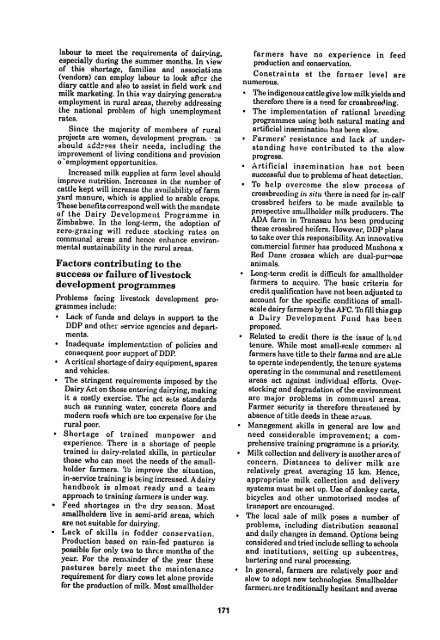aistand south~ern afrkca - (PDF, 101 mb) - USAID
aistand south~ern afrkca - (PDF, 101 mb) - USAID
aistand south~ern afrkca - (PDF, 101 mb) - USAID
Create successful ePaper yourself
Turn your PDF publications into a flip-book with our unique Google optimized e-Paper software.
labour to meet the requirements of dairying,<br />
especially during the summer months. In %iew<br />
of this shortage, families and associati.ms<br />
(vendors) can employ labour to look aftcr the<br />
diary cattle and also to assist in field work and<br />
milk marketing. In this way dairying generatrs<br />
employment in rural areas, thereby addressing<br />
the national problem of high unemployment<br />
rates,<br />
Since the majority of me<strong>mb</strong>ers of rural<br />
projects are women, development program. -s<br />
should address their needs, including the<br />
improvement of living conditions and provision<br />
o'employment opportunities.<br />
Increased milk supplies at farm level should<br />
improve nutrition. Increases in the nu<strong>mb</strong>er of<br />
cattle kept will increase the availability of farm<br />
yard manure, which is applied to arable crops.<br />
These benefits correspond well with the mandate<br />
of the Dairy Development Programme in<br />
Zi<strong>mb</strong>abwe. In the long-term, the adoption of<br />
zero-grazing w ill reduce stocking rates ono<br />
communal areas and hence enhance environmental<br />
sustainability in the rural areas,<br />
Factors contributing to the<br />
success or failure of livestock<br />
development programmes<br />
Problems facing livestock development programmes<br />
include:<br />
" Lack of funds and delays in support to the<br />
DDP and othe- service agencies and departments.<br />
" Inadequate implementation of policies and<br />
consequent poor support of DDP.<br />
" A critical shortage ofdairy equipment, spares<br />
and vehicles.<br />
* The stringent requirements imposed by the<br />
Dairy Act on those entering dairying, making<br />
it a costly exercise. The act s~ts standards<br />
such as running water, concrete floors and<br />
modem roofs which are too expensive for the<br />
rural poor.<br />
" Shortage of trained manpower and<br />
experience. There is a shortage of people<br />
trained in dairy-related skills, in particular<br />
those who can meet the needs of the smallholder<br />
farmers. 'lb improve the situation,<br />
in-service training is baing increased. Adairy<br />
handbook is almost ready and a team<br />
approach to training ihrmers is under way.<br />
" Feed shortages in the dry season. Most<br />
smallholders live in semi-arid areas, which<br />
are not suitable for dairying.<br />
" Lack of skills in fodder conservation,<br />
Production based on rain-fed pastures is<br />
possible for only two to thrce months of the<br />
year. For the remainder of the year these<br />
pastures barely meet the maintenance<br />
requirement for diary cows let alone provide<br />
for the production of milk. Most smallholder<br />
171<br />
farmers have no experience in feed<br />
production and conservation.<br />
Constraints at the farmer level are<br />
nuerous.<br />
• Theindigenouscattlegivelowmilkyieldsand<br />
therefore there is a need for crossbreeding.<br />
* The implementation of rational breeding<br />
programmes using both natural mating and<br />
artificial insemination has been slow.<br />
• Farmers' resistance and lack of understanding<br />
have contributed to the slow<br />
progress.<br />
. Artificial insemination has not been<br />
successful due to problems of heat detection.<br />
• To help overcome the slow process of<br />
crossbreeding in situ there is need for in-calf<br />
crossbred heifers to be made available to<br />
prospective smllholder milk producers. The<br />
ADA farm in Transsau hns been producing<br />
these crossbred heifers. However, DDP plans<br />
tae o ver h i es . An innovat s<br />
to take over this responsibility. An innovative<br />
commercial farmer has produced Mashona x<br />
Red Dane crosses which are dual-purnose<br />
animals.<br />
* Long-term credit is difficult for smallholder<br />
farmers to acquire. The basic criteria for<br />
credit qualification have not been adjusted to<br />
account for the specific conditions of smallscale<br />
dairy farmers by the AFC. 'b fill thisgap<br />
a Dairy Development Fund has been<br />
proposed.<br />
* Related to credit there is the issue of 1Lnd<br />
tenure. While most small-scale commen al<br />
farmers have title to their farms and are aLie<br />
to operate independently, the tenure systems<br />
operating in the communal and resettlement<br />
areas act against individual efforts. Overstocking<br />
and degradation ofthe environment<br />
are major problems in communal areas.<br />
Farmer security is therefore threatened by<br />
absence of title deeds in these areas.<br />
* Management skills in general are low and<br />
need considerable improvement; a comprehensive<br />
training programme is a priority.<br />
* Milk collection and delivery is another area of<br />
concern. Distances to deliver milk are<br />
relatively great, averaging 15 km. Hence,<br />
appropriate milk collection and delivery<br />
systems must be set up. Use of donkey carts,<br />
bicycles and other unmotorised modes of<br />
transport are encouraged.<br />
• The local sale of milk poses a nu<strong>mb</strong>er of<br />
problems, including distribution seasonal<br />
and daily changes in demand. Options being<br />
considered and tried include selling to schools<br />
and institutions, setting up subcentres,<br />
bartering and rural processing.<br />
• In general, farmers are relatively poor and<br />
slow to adopt new technologies. Smallholder<br />
farmers are traditionally hesitant and averse

















